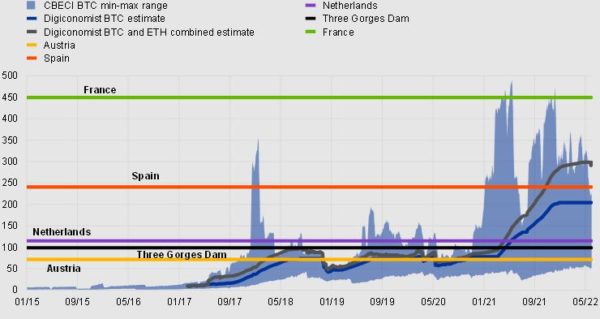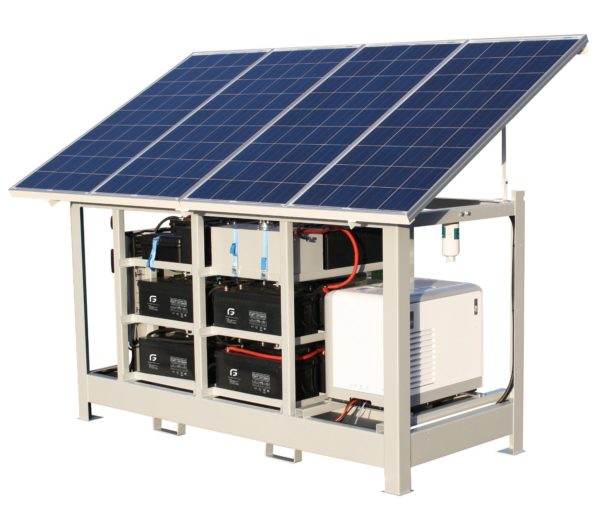Bitcoin, Ethereum, and many other cryptocurrencies have come under spotlight for their disruption of financial markets. But one unintended consequence has been the disruption of the global energy market.
Bitcoin was estimated to burn about 76 billion kWh last year, about triple that of Ethereum. There are thousands of types of coins, and new ones springing up by the day.
The process of generating a unique coin is called mining, which may be an apt name for the practice, as it is a highly physical activity, and not the ethereal, cloud-like process that it may appear to be on surface. High-powered servers, or mining rigs, are required to show “proof of work,” performing increasingly complex math equations in the process of minting a unique coin. This requires a lot of energy, and in turn, expels a lot of carbon.
Fortune magazine said Bitcoin deploys an incredible 707 kWh and emits half a ton of carbon per transaction. This is hundreds of thousands of times the energy required by a credit card transaction. While cryptocurrency is hailed for increasing financial security through decentralisation, is the juice worth the squeeze?

Image: Wikimedia Commons
In response to this criticism, organisations like the Crypto Climate Accord and the Bitcoin Mining Council (BMC) have been formed to, “promote transparency, share best practices, and educate the public on the benefits of bitcoin and bitcoin mining.”
BMC said, “bitcoin mining uses a negligible amount of energy, is rapidly becoming more efficient, and is powered by a higher mix of sustainable energy than any major country or industry.” It is estimated that about 50% of bitcoin mining is renewably powered, but lack of quality data and transparency challenge this figure.
Cambridge University’s Bitcoin Electricity Consumption Index shows that in less than ten years, Bitcoin’s energy demand has increased from near-nothing about 200 TWh a year, more than the Netherlands and Austria, and nearly as much as Spain, which uses about 250 TWh each year. Its consumption is multiples higher than the Three Gorges Dam, the world’s largest power plant in terms of capacity.

Renewable energy represents roughly 28% of the world’s energy mix, indicating that there is much work to do to achieve carbon neutrality. By sharply increasing the demand for electricity, crypto mining can crowd out renewable energy development that could power other important functioning aspects of the economy like agriculture and transportation.
Climate may challenge crypto value
The carbon impact of cryptocurrency may impact its valuation going forward, said the European Central Bank. Last year, China placed a ban on all crypto transactions amid financial stability, consumer protection, financial crime, and environmental concerns. The European Parliament plans to submit a legislative report by 2025 on the climate impact of cryptocurrency, and New York State passed a bill that placed a two-year ban on certain carbon-based crypto mining operations.
Investment in cryptocurrencies may pose risks to corporations that have set environmental, social, and governance goals. Worldwide, a large group of banks representing 40% of global banking assets have voluntarily committed to achieving net zero emissions in their lending and investment portfolios by 2050. Transparency is difficult to achieve with cryptocurrency mining, meaning these banks and corporations may be unwilling to take on the risk of investment if it means compromising carbon emissions goals.
Solar mining kit
Distributed, decentralized power may be the best match to mitigate the environmental damage of cryptocurrency if it is to continue on this path. Solar and energy storage built in a distributed fashion can lessen the need for transmission infrastructure, reducing the overall raw material input supporting currency mining. It would also ensure a given mining operation is 100% renewably powered, rather than the roughly estimated 50% that powers it today.

Image: Mecobit
One company working in this space is MECO Limited, which recently released a solar panel kit along with a portable power station, to be coupled with its mining equipment. The new products are called the Mecobit Solar Unit M4000 and Solar Panel Kit.
Included in the portable Solar Unit M4000 is a lithium-ion battery bank and eight solar panels with a combined rated power of 3 kW. The Solar Panel Kit is a 2 kW model that integrates panels on top of a rack, with battery storage and the crypto miners mounted below.
The two kits are compatible with most home and Industrial appliances, equipment, tools, electronic devices such as cryptocurrency miners, providing backup and durable power for home and office use. While cryptocurrency mining could represent one destiny for the power generated by the system, it could also be used for essentials like refrigeration, heating and cooling, medical devices, lighting, and more.
This content is protected by copyright and may not be reused. If you want to cooperate with us and would like to reuse some of our content, please contact: editors@pv-magazine.com.









33 comments
By submitting this form you agree to pv magazine using your data for the purposes of publishing your comment.
Your personal data will only be disclosed or otherwise transmitted to third parties for the purposes of spam filtering or if this is necessary for technical maintenance of the website. Any other transfer to third parties will not take place unless this is justified on the basis of applicable data protection regulations or if pv magazine is legally obliged to do so.
You may revoke this consent at any time with effect for the future, in which case your personal data will be deleted immediately. Otherwise, your data will be deleted if pv magazine has processed your request or the purpose of data storage is fulfilled.
Further information on data privacy can be found in our Data Protection Policy.